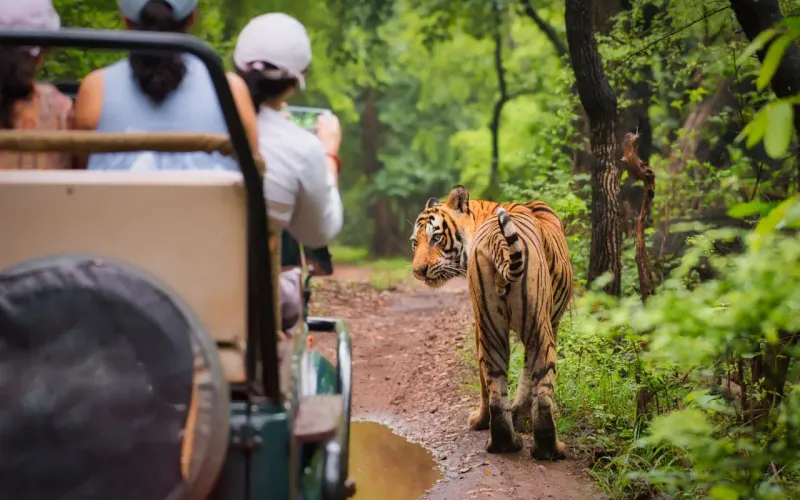📖 Table of Content:
Recent studies indicate that tigers are indeed adapting to human-dominated environments, demonstrating resilience and the ability to coexist with human populations. In India, a comprehensive study published in February 2025 revealed that over the past two decades, the tiger population has increased by 30%, with tigers now sharing habitats with approximately 66 million people. This coexistence is facilitated by a combination of protected reserves and multi-use landscapes where tigers and humans share space. Similarly, in Nepal’s Chitwan National Park, tigers have adapted to human presence by becoming more nocturnal, reducing daytime activity when human activities peak. These findings underscore the potential for tigers to thrive in human-dominated landscapes, provided there is effective conservation management, habitat protection, and community engagement.
1. India’s Thriving Tigers
In the heart of India, tigers are reclaiming their reign. Over two decades, their population surged by 30%, thriving amidst human presence. This thriving population isn’t just surviving but thriving, thanks to strategic conservation efforts. Protected reserves offer safety, while multi-use landscapes encourage coexistence. Tigers are increasingly seen prowling near villages, symbolizing resilience. Cultural reverence for tigers further supports their survival, fostering an environment where humans and tigers share space in harmony. Economic initiatives around tiger tourism have also provided incentives for local communities to participate in conservation efforts, enhancing this coexistence.
2. Nepal’s Nocturnal Tigers
In Nepal’s Chitwan National Park, tigers have taken on the night. Adapting to human activity, these majestic creatures have become more nocturnal. This shift minimizes conflicts by allowing both species to use the land at different times. Roaming silently through moonlit forests, tigers hunt and patrol territories, avoiding the bustling daytime. This adjustment illustrates their remarkable resilience and flexibility. Local communities are gradually recognizing the benefits of these adaptations, promoting peaceful coexistence. This behavioral change has not only reduced human-wildlife conflicts but also increased opportunities for night-time eco-tourism, creating economic benefits.
3. Conservation Triumphs
Conservation efforts are the unsung heroes of tiger adaptation. With a blend of technology and traditional methods, habitats are restored, and poaching is curtailed. Camera traps and ranger patrols ensure safety, while community engagement fosters understanding. These efforts have resulted in safe havens where tigers roam freely. An intricate network of protected areas linked with corridors allows genetic diversity and expansion of territories. The success of these measures is evident in the growing population numbers, showcasing the effectiveness of dedicated conservation strategies. The commitment of conservationists worldwide fuels hope for future generations of tigers.
4. Cultural Reverence and Tigers
In certain cultures, tigers are not just animals—they are revered icons. In India, tigers are woven into myths, art, and daily life, seen as symbols of power and grace. This cultural reverence plays a crucial role in their conservation. Festivals celebrate their majesty, and traditional stories inspire respect and protection. Communities are motivated to safeguard these creatures, viewing them as integral to their heritage. This deep-rooted respect translates into tangible conservation efforts, where local beliefs align with modern ecological strategies. Such cultural ties empower local populations to actively engage in protecting tigers.
5. Economic Benefits of Tiger Conservation
Tiger conservation is not just about saving a species—it’s an economic boon. Reserves and parks attract tourists, generating revenue and supporting local economies. Villages near tiger habitats see a surge in business, from safari tours to souvenir shops. This economic incentive bolsters conservation as communities see a tangible return on their efforts. Tourist dollars fund conservation projects, ensuring ongoing protection. The positive economic impact reinforces the value of preserving tiger habitats, aligning ecological goals with economic interests. As more tourists flock to witness these majestic creatures, the cycle of conservation and economic growth continues.





